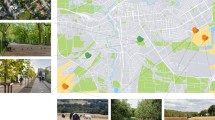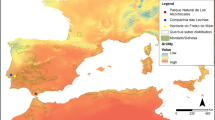Abstract
This paper discusses participatory processes in wildland fire management (WFM). Participation is an essential element of both the European Sustainable Development (SD) Strategy and the White Paper on Governance. Governance and SD have thus become an interconnected challenge to be applied to WFM (as a sub-area in forest policy), amongst other policies. An overspread weakness in WFM is lack of real participation of stakeholders. Absence of (or deficient) participation can seriously impair contribution of this group to WFM in high-risk areas and runs counter governance and the SDS. Further, this weakness might prevent an efficient use of fire as a land management tool (prescribed burning, PB) and as a technique for fighting wildfire (suppression fire, SF). Even though these fire practices have been well known in many different places, they have been increasingly neglected or prohibited over time in Southern Europe. At present, forest and fire fighting administrations are turning their eyes back on them and analyzing the benefits of using fire in relation to preventive and suppressive actions. Therefore, participatory and diffusion mechanisms (the latter adopting the shape of national and international experts’ networks) are required in order to solve the socalled fire paradox: that is, the need to move from a one-dimensional perception of the negative impacts of fire to a more sophisticated one that also stresses its positive effects. Governance, based on broad social participation, and diffusion, through fire networks, are of utmost importance in order, first, to diminish long-standing suspicion amongst different interests as to the use of fire and, secondly, to diffuse best practices associated with PB and SF. Most importantly, the EU should exercise its environmental leadership so that these new fire practices and sustainable WFM are diffused across the international arena.
Similar content being viewed by others
References
Aguilar Fernández SA. 1997. El reto del medio ambiente, Madrid, Alianza Universidad.
Aguilar Fernández SA. 2004. Sustainability is cool: rhetorical participatory discourse in the Spanish strategy for sustainable development. In: William M. Lafferty (ed), Governance for Sustainable Development: The Challenge of Adapting Form to Function. Cheltenham, UK: Edward Elgar Publishing Limited, pp.128–161.
Ascoli D, Beghin R, Ceccato R, Gorlier A, Lombardi G, Lonati M, Marzano R, Bovio G, Cavallero A. 2009. Developing an adaptive management approach to prescribed burning: a long-term heathland conservation experiment in north-west Italy. International Journal of Wildland Fire, 18(6): 727–735.
Barry J. 1996. Sustainability, Political Judgement and Citizenship: Connecting Green Politics and Democracy. In: Brian Doherty and Marius de Geus (eds), Democracy & Green Political Thought. London: Routledge.
Börzel T. 2003. Environmental leaders and laggards in Europe. Aldershot, Burlington, Singapore, Sydney: Ashgate.
Botelho H, Fernandes PM. 1997. Controlled burning in the Mediterranean countries of Europe. European Commission; Environment & Climate Programme; Advanced Study Courses; Marathon; 6–14 October 1997. pp. 163–170.
DG JRC-IES. 2005. Forest Fires in Europe. Report no 6/2005. JRC Scientific and Technical Reports, p.54.
FAO. 1999. Report of meeting on public policies affecting forest fires, 14th session, Rome, Italy, 28–30 October 1998, I. Part 1.
FAO. 2006. Fire management: Voluntary guidelines-Principles & strategic actions. Fire management Working Paper FM17E. Rome. p.71. Available on www.fao.org/forestry/site/35853/en
Fernandes P. 2002. Prescribed fire: strategies and management. In: Pardini, G. and Pintó, J. (eds.), Fire, Landscape and Biodiversity: an appraisal of the effects and effectiveness. Diversitas 29. Universitat de Girona, Institut de Medi Ambient, Girona: pp.187–200.
Galiana L, Aguilar S, Herrero G. 2011. An assessment of the effects of forestrelated policies upon wildland fires in the European Union: Applying the Subsidiarity Principle. Forest Ecology and Planning (forthcoming).
Glück P and Voitleithner J (eds.). 2004. NFP Research: Its Retrospect and Outlook. Proceedings of the Seminar of COST Action E19 “National Forest Programmes in a European Context”, September 2003, Vienna. Publication Series of the Institute of Forest Sector Policy and Economics - Vol.52, Vienna.
Goldammer JG. 1998. History of fire in land-use systems of the Baltic Region: Implications on the use of prescribed fire in forestry, nature conservation and landscape management. Paper presented in First Baltic Conference on Forest Fires, Radom-Katowice, Poland, 5–9 May 1998.
Herrero G, Montiel C, Agudo J, Aguilar S. 2008. Assessment document on the main strengths and weaknesses of the legislation and policy instruments concerning integrated wildland fire management in the EU, in European Member States and in North African countries. Deliverable D.7.1-1-2 of the Integrated project “Fire Paradox”, Project no. FP6-018505, European Commission (available on http://www.fireparadox.org).
Hesseln H. 2006. An assessment of domestic and foreign wildfire policy (unpublished).
Hughes R, Mercer D. 2009, Planning to reduce risk: the wildfire management overlay in Victoria, Australia. Geographical Research, 47(2): 124–141.
Jordan G. 1993. The new right and public policy: a preliminary overview. In: Grant Jordan and Nigel Ashford (eds.), Public Policy and the Impact of the New Right. London and New York: Pinter Publisher, pp.46–58.
Jörgens H. 2004. Governance by diffusion: implementing global norms through cross-national imitation and learning, In: William M. Lafferty (ed), Governance for Sustainable Developmen: The Challenge of Adapting Form to Function. Cheltenham, UK: Edward Elgar Publishing Limited, pp. 246–283.
Lafferty W. 2004. “Preface”. In: William M. Lafferty (ed), Governance for Sustainable Development: The Challenge of Adapting Form to Function. Cheltenham, UK: Edward Elgar Publishing Limited.
Lambert B. 2008. Bilan et perspectives du réseau Brûlage Dirigé, 30p.
Lázaro A, Herrero G, Montiel C, Molina D. 2008, Organización de la defense contra incendios forestales en el Estado de las Autonomías: el caso español., Revista Forestal Española, no. 40, pp. 13–20.
Lázaro A, Montiel C. 2010. Overview of prescribed burning policies and practices in Europe and other countries. In: Sande Silva, J., Fernandes & Rigolot, E. (eds.), Towards Integrated Fire Management-Outcomes of the European Project Fire Paradox. European Forest Institute Research Report, 23, pp.137–150.
Leone V. 1999. Constraints and opportunities in prescribed burning development. Deliverable 1. FIRE TORCH project. Prescribed burning as a tool for the Mediterranean region: a management approach, p.43.
Meadowcroft J. 2004 Participation and sustainable development: modes of citizen, community and organisational involvement. In: William M. Lafferty (ed), Governance for Sustainable Development: The Challenge of Adapting Form to Function. Cheltenham, UK: Edward Elgar Publishing Limited, pp.163–190.
Métailié JP. 2006. Mountain landscape, pastoral management and traditional practices in the Northern Pyrenées (France). In: Anoletti, M. (ed.), The conservation of Cultural Landscapes, CAB International, pp.108–124.
Mette Kjaer A. 2004. Governance. Cambridge: Polity Press.
Montiel C, and San-Miguel J. 2009. Policy analysis reveals the need for new approaches. In: Birot, Y. (ed.), Living with wildfires: what science can tell us. A contribution to the Science-Policy Dialogue, European Forest Institute, Discussion Paper 15, pp. 63–67.
Montiel C, Costa P, Galán M. 2010. Overview of suppression fire policies and practices in Europe. In: Sande Silva, J., Fernandes & Rigolot, E. (ed.): Towards Integrated Fire Management-Outcomes of the European Project Fire Paradox. European Forest Institute Research Report, 23, pp. 177–187.
Montiel C, Herrero G, Lázaro A, Agudo J, Aguilar S. 2008. List and classification of the existing EU and national forest legislation and national policy instruments with reference to wildland, suppression and prescribed fires. Deliverable D.7.1-1-1 of the Integrated project “Fire Paradox”, Project no. FP6-018505, European Comisión (available on http:www.fireparadox.org)
Montiel C, Herrero G. 2010. Overview of policies and practices related to fire ignitions. In: Sande Silva, J., Fernandes & Rigolot, E. (eds.), Towards Integrated Fire Management-Outcomes of the European Project Fire Paradox. European Forest Institute Research Report, 23, 35–46.
Pyne SJ, Andrews PL, Laven RD. 1996. Introduction to Wildland Fire, 2nd edition. New York: John Wiley and Sons.
Pyne SJ. 1997. Vestal Fire. An environmental history told through fire, of Europe and Europe’s encounter with the world. Washington: University of Washington Press.
Rego F, Rigolot E, Fernandes P, Montiel C, Sande Silva J. (eds.). 2010. Towards Integrated Fire Management, EFI (European Forest Institute) Policy Brief 4.
Ribet N. 2008. Le brûlage dirigé, une revolution plus politique que technique. INFO DFCI Bulletin su centre de documentation « Forêt Méditerranéenne et incendie », Juin 2008 No. 60: 1–4
Rigolot E. 1995. Le brûlage dirigé en région méditerranéenne française. INFO DFCI Juin 1995 No.34, 1:3
Rigolot E. 2000. Le brûlage dirigé en France: outil de gestion et recherches asocies. In: Vega, J. A. & Vélez, R (coord.), Actas de la Reunión sobre quemas prescritas, Cuadernos de la Sociedad Española de Ciencias Forestales, no. 9, pp.165–178.
Rigolot E. 2005. Brûlage dirigé: Quinze ans d’expérimentation. Espaces Naturales, no. 12, October 2005, 16–17
Salgueiro A. 2006. Le Portugal sans incendies, c’est un Portugal qui a intégre la gestion par le feu. In: Lambert & Rigolot. XVII Rencontres des Équipes de Brûlage Dirigé. Rosans (Hautes-Alpes)-7 au 9 Juin 2006. Edition La Cardère, p44.
Vega JA, Vélez R (coord.). 2000. Actas de la Reunión sobre quemas prescritas. Cuadernos de la Sociedad Española de Ciencias Forestales, no. 9, p.283.
Vélez R. 1988. El fuego prescrito en los planes de prevención de los incendios forestales. In: Proceeding of the International Workshop on Prescribed Burning, FAO March 14–18 1988, pp. 53–57
Vélez R. 2005. La población rural en la prevención de incendios forestales. Documento de Trabajo sobre Protección Forestal FFM/4/E, FAO, Rome
Wade D, Lunsford JD. 1989. A guide for prescribed fire in Southern forests. USDA For. Serv. Tech. Pub. R8-TP 11, Southern Region. Atlanta, Georgia.
Author information
Authors and Affiliations
Corresponding author
Additional information
Foundation project: This paper has to be framed within the FIRE PARADOX Integrated Project, “An innovative approach of Integrated Wildland Fire Management Regulating the Wildfire Problem by the Wise use of Fire: solving the Fire Paradox”, financed by the VI Framework Programme, Sub-priority 6.3 Global Change and Ecosystems (www.fireparadox.org).
The online version is available at http://www.springerlink.com
Rights and permissions
About this article
Cite this article
Aguilar, S., Montiel, C. The challenge of applying governance and sustainable development to wildland fire management in Southern Europe. Journal of Forestry Research 22, 627–639 (2011). https://doi.org/10.1007/s11676-011-0168-6
Received:
Accepted:
Published:
Issue Date:
DOI: https://doi.org/10.1007/s11676-011-0168-6




